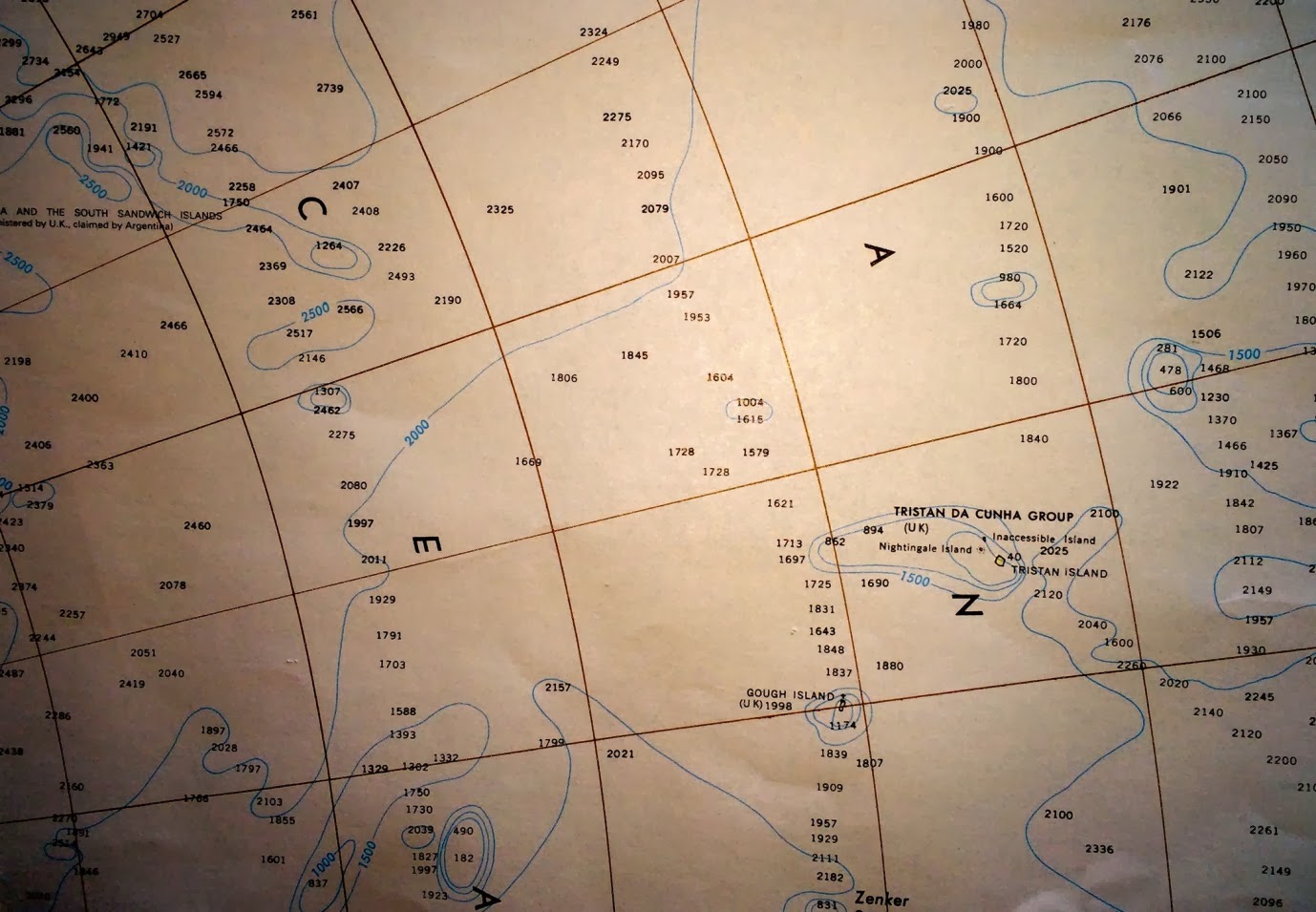CLIVAR A16S (GO-SHIP/CO2 Repeat Hydrography Cruise)
05:00 23 Dec 2013, the RV Ronald H. Brown left the port city of Recife in NE Brazil for a 45 day research cruise that will occupy 115 stations from 6-60
oS. Starting in warm tropical waters just past the extent of the Brazilian EEZ (200 nautical miles from the Brazilian coast), a test cast was done to check that everything was operational on the main CTD rosette, and our smaller, trace metal CTD rosette. Sampling then began at Station 1 (where else would you start?), which is an 'overlap' station. The first station on this cruise was the last station occupied on A16N at the end of September; hence, the overlap. Over the course of the next few weeks the temperature will gradually decrease, and we will end the cruise in the iceberg fields of the S. Atlantic, before heading into port in Punta Arenas, Chile.
Much is the same on A16S as it was on A16N (you can refresh your memory of what we were doing earlier this year here:
http://eoas-fsu-clivar.blogspot.com/). Again the trace metal team has four members: Drs. Bill Landing and I (Rachel Shelley), from FSU, and Drs. Chris Measures and Mariko Hatta, from the University of Hawaii (UH). I will be collecting aerosol and rain samples again, in order to quantify the flux of trace elements to the ocean from the atmosphere (one of the major input pathways of essential and pollution-derived trace elements to the ocean). We will also be collecting water column samples for dissolved and particulate trace metals (Al, Cd, Co, Cu, Fe, Mn, Ni, Pb, Zn) that we will take back to FSU and analyze using Inductively Coupled Plasma - Mass Spectrometry (ICP-MS) at the National High Magnetic Field Laboratory. The UH team will be conducting shipboard determinations of dissolved Al, Fe, Mn and Zn. Why these four? And why dissolved?
The dissolved form (specifically the fraction that passes through a 0.45 µm filter) of trace metals is the fraction most readily available for uptake by phytoplankton (primary producers).
Aluminum (Al; or aluminium as Chris and I say - this time the trace metal team has gone international; Chris and I are British, Mariko is Japanese and Dr. Landing is our token American) is an excellent tracer of continental material (mineral dust), delivered via atmospheric deposition, as it is a major component of mineral dust (due to the alumina-silicate matrix of mineral dust).
Iron (Fe) is an essential element for phytoplankton growth (primary production). Phytoplankton have many requirements for Fe; photosynthesis and nitrogen acquisition are just two examples. However, in up to 40% of the global ocean primary production is limited by Fe availability (i.e. there isn't enough of it to sustain high biomass). The reason we are so interested in Fe availability is that ca. 50% of photosynthesis occurs in the ocean, and photosynthesis is directly responsible for the removal of carbon dioxide (CO
2 ) from the atmosphere. This is the chemical reaction that describes photosynthesis (which occurs in the presence of sunlight):
6H2O +
6CO2 à 6H12O6 + O2
(water + carbon dioxide à carbohydrate + oxygen)
Manganese (Mn) is also an essential trace metal for phytoplankton growth. Like Fe, phytoplankton also have a requirement for Mn in photosynthesis. Dissolved Mn in the water column can also be used as an indicator of sedimentary inputs. So, correlations between Fe and Mn can indicate a common sedimentary source in much the same way as correlations between Fe and Al can be used to indicate a common atmospheric source.
Using these two trace metals (Al and Mn) as tracers gives us a way to identify the source of other biologically-important trace metals (such as Fe) to the ocean. Quantification of the different inputs of Fe is of interest as the amount of Fe (as well as other essential elements and pollution elements) entering marine systems is likely to change given changing land use, and increasing industrialization and urbanization. There is much uncertainty about how such changes will impact Fe inputs, but by providing data to modelers they can make predictions about how differences in inputs might affect marine ecosystems and carbon cycling in the future.
Zinc (Zn) is another essential element for phytoplankton, as it is required for carbon acquisition. Zinc is notoriously hard to determine in seawater, due to its very low concentrations, and because without extremely careful sample handling, samples are easily contaminated (this is something Zn and Fe analysis have in common).
This is the set-up that Chris and Mariko are using to analyze their samples:
 |
| Mariko at work in the laminar flow hood |
This type of system is called Flow Injection Analysis (FIA). They are using one FIA system per trace metal. To minimize contamination the van is under positive pressure, and the samples and reagents are kept in a laminar flow hood.
Christmas and New Year's Eve at sea on the RV Ronald H. Brown
 |
| The mess deck decorated for Christmas |
 |
| The trace metal clean van/lab decorated for Christmas, with the FIA system along the right |
 |
Christmas caroling in the lounge.
|
Field Operations Officer, Lt. Paul Chamberlain, is holding sheet music he downloaded to his phone for Lora van Uffelen (U. Hawaii) to read, while Julia Payne, a joint chemistry and music major (U. Miami/RSMAS) plays bassoon in the background.
 |
| The Christmas tree in the lounge |
 |
New Year's Eve party in the gym (theme: black and white).
The ship's doctor, Dan Deleon, won the prize for the best mask. |














